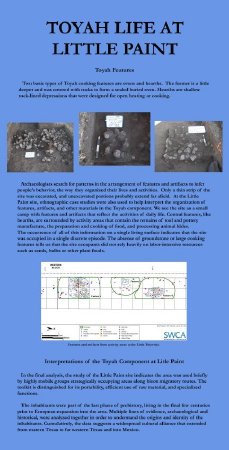Title:
Panel 6: Toyah Life at Little Paint
Collection:
Little Paint Collection
Object ID:
CAS.2013.07.PIC.87
VE Exhibit Label 1:
TOYAH LIFE AT LITTLE PAINT
Toyah Features
Two basic types of Toyah cooking features are ovens and hearths. The former is a little deeper and was covered with rocks to form a sealed buried oven. Hearths are shallow rock—lined depressions that were designed for open heating or cooking.
Toyah Features
Two basic types of Toyah cooking features are ovens and hearths. The former is a little deeper and was covered with rocks to form a sealed buried oven. Hearths are shallow rock—lined depressions that were designed for open heating or cooking.
VE Exhibit Label 2:
Archaeologists search for patterns in the arrangement of features and artifacts to infer people's behavior, the way they organized their lives and activities. Only a thin strip of the site was excavated, and unexcavated portions probably extend far afield. At the Little paint site, ethnographic case studies were also used to help interpret the organization of features, artifacts, and other materials in the Toyah component. We see the site as a small camp with features and artifacts that reflect the activities of daily life. Central features, like hearths, are surrounded by activity areas that contain the remains of tool and pottery manufacture, the preparation and cooking of food, and the processing of animal hides. The occurrence of all of this information on a single living surfaceindicates that the site was occupied in a single discrete episode. The absense of groundstone or large cooking features tells us that the site occupants did not rely heavily on labor—intensive resources such as seeds, bulbs or other plant foods.
VE Exhibit Label 3:
Interpretations of the Toyah Component at Little Paint
In the final analysis, the study of the LIttle Paint site indicates the ares was used briefly by highly mobile groups strategically occupying areas along bison migratory routes. The toolkit is distinguished for its portability, efficient use of raw material, and specialized functions.
The inhabitants were part of the last phase of prehistory, living in the final few centuries prior to European expansion into the area. Multiple lines of evidense, archaeological and historical, were analyzed together in order to understand the origins and identity of the inhabitants. Cumulatively, the data suggests a widespread cultural alliance that extended from eastern texas to far western texas and into Mexico.
In the final analysis, the study of the LIttle Paint site indicates the ares was used briefly by highly mobile groups strategically occupying areas along bison migratory routes. The toolkit is distinguished for its portability, efficient use of raw material, and specialized functions.
The inhabitants were part of the last phase of prehistory, living in the final few centuries prior to European expansion into the area. Multiple lines of evidense, archaeological and historical, were analyzed together in order to understand the origins and identity of the inhabitants. Cumulatively, the data suggests a widespread cultural alliance that extended from eastern texas to far western texas and into Mexico.
